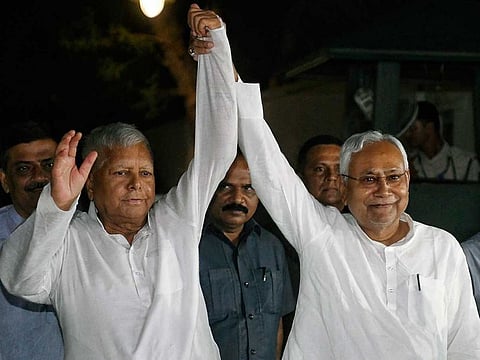India: Caste census will play a decisive role in 2024 elections
Caste numbers in Hindi heartland could damage the BJP’s impressive vote share

The original social justice warriors — Bihar Chief Minister Nitish Kumar and Lalu Prasad Yadav, who currently runs the Bihar government — have made public the state’s caste census report.
The results are expected to roil India’s politics. The census report puts the number of the other backward castes (OBC) at 27 per cent of the population and the extremely backward castes (EBC) at 36 per cent. The OBC plus EBC is 63 per cent, against which they have a reservation of 27 per cent. Bihar’s population is 13 crore (130 million). Dalits (lower caste) constitute 19 per cent of the population and tribals are 1.68 per cent. The upper castes are 15.5 per cent of the population.
SWAT analysis readers will recall that I had predicted last week that the opposition INDIA alliance would make caste census the central issue in its joint fight against the BJP.
The reservation cap
As the Mahagatbandhan alliance, one of the key constituents of the INDIA grouping went public with the caste numbers on Gandhi Jayanti (Gandhi’s birthday, October 2), the issue took centre stage.
For Mandal 2.0, the political equations in Bihar are clear. Kumar, who is keen to jockey himself as the “sootradhar” (control figure) of the INDIA alliance, wants to breach the 50 per cent cap on reservation stipulated by the Supreme Court of India. Interestingly, a trial balloon was floated by the opposition-run Hemant Soren government in Jharkhand, which proposed a bill of 77 per cent reservation. The Jharkhand Governor C.P. Radhakrishnan, rejected the bill for being in breach of the Supreme Court cap.
The only government currently breaching the 50 per cent cap is Tamil Nadu, which brought in the reservation before the Supreme Court stipulation kicked in.
Delimitation and caste reset welfare measures in breach of the 50 per cent ceiling are potent issues that can intensify the political fault lines as the big fight of 2024 draws closer.
A senior opposition leader told Gulf News that the demand for a caste census and increasing reservation and representation across all sectors, including government and education, will be a central promise of the INDIA alliance. “See the numbers; they tell a compelling story,” he said.
The BJP had initially demanded a caste census in 2010, but following pressure from the Rashtriya Swamsevak Sangh (RSS), the mothership of the Sangh had gone silent. Now the BJP opposes it, a shift the opposition has sensed. The caste numbers in the Hindi heartland of Uttar Pradesh, Bihar and Madhya Pradesh could theoretically damage the BJP’s impressive vote share, particularly in UP.
Why caste-based deal could be a gamechanger
Compared to southern India, the Hindi heartland is backward and looks at the government as a huge source of employment. So any reservation policy changes, specifically a percentage increase in reservation, could again upend politics in UP.
The 80 Lok Sabha seats in UP are critical in the political chessboard of India, and it’s a cliche in Indian politics that the route to the Delhi throne runs through Lucknow. This is realpolitik for the BJP and Modi.
Yogi Adityanath, the second-term BJP CM seen as future prime minister and Modi’s heir, has been tasked to deliver UP. Modi and Yogi are electoral totems for the BJP and widely popular across the state. However, the opposition sees a new caste-based deal that could be a gamechanger.
But the Mandal upheaval in politics may have already happened. A senior BJP leader says, “The recalibration and political reset has already happened. The BJP under Modi is a post-Mandal party; the opposition as usual is living in the past. No backward or extremely backward caste looks at the BJP as the enemy. They acknowledge that Modi is an OBC leader, although they don’t state it explicitly”.
However, rising unemployment is a worry for the BJP in the centre and across India. The BJP response is likely to be a delimitation of constituencies with a larger share to states with larger numbers of people. This has no takers in south India, which feels that it is punished for controlling population numbers with widespread education and welfare measures.
Delimitation and caste reset welfare measures in breach of the 50 per cent ceiling are potent issues that can intensify the political fault lines as the big fight of 2024 draws closer. Watch this space.
Sign up for the Daily Briefing
Get the latest news and updates straight to your inbox








